Synthesis and Characterisation of Novel Bis(diphenylphosphane oxide)methanidoytterbium(III) Complexes
Abstract
1. Introduction
2. Results and Discussion
2.1. Synthesis and Characterisation of [Yb(HdppmO2)3] 1
2.2. Solid State Structure of [Yb(HdppmO2)3] 1
2.3. Properties of [Yb(HdppmO2)3] 1 in Solution
2.4. Synthesis of 1 by the RTP Method
2.5. Synthesis of [Yb4(µ-HdppmO2)6(µ-F)6] 2
2.6. Solid State Structure of [Yb4(µ-HdppmO2)6(µ-F)6] 2
3. Materials and Methods
3.1. General Procedures
3.2. Single Crystal X-ray Structure Determination
3.3. Computational Studies
3.4. Experimental Section
3.4.1. Preparation of [Yb{(Ph2PO)2CH}3] (1)
3.4.2. Preparation of [Yb4{(Ph2PO)2CH}6F6] (2)
4. Conclusions
Supplementary Materials
Author Contributions
Funding
Institutional Review Board Statement
Informed Consent Statement
Data Availability Statement
Acknowledgments
Conflicts of Interest
References
- Hart, F.A. Scandium, Yttrium and the lanthanides, Chapter 39. In Comprehensive Coordination Chemistry; Pergamon Press: Oxford, UK, 1987; Volume 3. [Google Scholar]
- Cotton, S. Scandium, Yttrium and the Lanthanides, Chapter 3.2, Section 3.2.2.5.2. In Comprehensive Coordination Chemistry II; Elsevier: Amsterdam, The Netherlands, 2003; Volume 3. [Google Scholar]
- Guino-o, M.A.; Bustrom, B.; Tigaa, R.A.; de Bettencourt-Dias, A. Microwave-assisted synthesis of ternary lanthanide(2-thenoyltrifluoroacetone)3(triphenylphosphine oxide)2 complexes. Inorg. Chim. Acta 2017, 464, 23–30. [Google Scholar] [CrossRef]
- Platt, A.W.G. Lanthanide phosphine oxide complexes. Coord. Chem. Rev. 2017, 340, 62–78. [Google Scholar] [CrossRef]
- Moeller, T. Gmelin Handbook of Inorganic Chemistry; Springer: Berlin/Heidelberg, Germany, 1983; System 39, Part D6. [Google Scholar]
- Deacon, G.B.; Gatehouse, B.M.; White, P.A. Organolanthanides—XVI. Preparation and structure of bis(η5-cyclopentadienyl)bis(triphenylphosphine oxide)ytterbium(II)—The first X-ray crystal structure of a phosphine oxideorganolanthanide(II) complex. Polyhedron 1989, 8, 1983–1987. [Google Scholar] [CrossRef]
- Deacon, G.B.; Fallon, G.D.; Forsyth, C.M.; Gatehouse, B.M.; Junk, P.C.; Philosof, A.; White, P.A. Organolanthanoids XXIII1 complexes of tris(cyclopentadienyl)lanthanoids with tertiary phosphine oxides and the X-ray crystal structures of [YbCp3(OPPh3)] and [NdCp3(OPBun3)]2. J. Organomet. Chem. 1998, 565, 201–210. [Google Scholar] [CrossRef]
- Deacon, G.B.; Forsyth, C.M.; Gatehouse, B.M.; Philosof, A.; Skelton, B.W.; White, A.H.; White, P.A. Organolanthanoids. XXI Synthesis of Bis- and Tris-(diphenylphosphinocyclopenta- dienyl)lanthanoid Compounds and the X-ray Crystal Structures of [Ln(C5H4PPh2)3(OPPh3)]·(thf)1. Aust. J. Chem. 1997, 50, 959–970. [Google Scholar] [CrossRef]
- Aspinall, H.C.; Moore, S.R.; Smith, A.K. Synthesis and crystal structure of a lanthanum complex with a diphenylphosphide ligand. J. Chem. Soc. Dalton trans. 1992, 153–156. [Google Scholar] [CrossRef]
- Deacon, G.; Gatehouse, B.; White, P. Preparation and X-Ray Structure of [YbIII(η5-C5H5)2(OPPh3)(OPPh2C5H4)]—A Complex With Oxygen Rather Than Cyclopentadienide Coordination of a Novel Ambidentate Ligand. Aust. J. Chem. 1992, 45, 1939–1941. [Google Scholar] [CrossRef]
- Evans, W.J.; Grate, J.W.; Doedens, R.J. Organolanthanide and organoyttrium hydride chemistry. 7. Reaction of the samarium-hydrogen bond in the organosamarium hydride [(C5Me5)2SmH]2 with carbon monoxide: Formation, isomerization, and X-ray crystallographic characterization of the samarium complexes cis- and trans-{(C5Me5)2[(C6H5)3PO]Sm}2(.mu.-OCH:CHO). J. Am. Chem. Soc. 1985, 107, 1671–1679. [Google Scholar]
- Cosgriff, J.; Deacon, G.; Gatehouse, B.; Hemling, H.; Schumann, H. Organoamido- and Aryloxo-lanthanoids. X. Tris(η2-3,5-di-t-butylpyrazolato)lanthanoid(III) Complexes and the X-Ray Crystal Structure of Er(η2-But2pz)3(thf)2. Aust. J. Chem. 1994, 47, 1223–1235. [Google Scholar] [CrossRef]
- Bradley, D.C.; Ghotra, J.S.; Hart, F.A.; Hursthouse, M.B.; Raithby, P.R. Low co-ordination numbers in lanthanoid and actinoid compounds. Part 2. Syntheses, properties, and crystal and molecular structures of triphenylphosphine oxide and peroxo-derivatives of [bis(trimethylsilyl)-amido]lanthanoids. J. Chem. Soc. Dalton Trans. 1977, 12, 1166–1172. [Google Scholar] [CrossRef]
- Casey, K.C.; Brown, A.M.; Robinson, J.R. Yttrium and lanthanum bis(phosphine-oxide)methanides: Structurally diverse, dynamic, and reactive. Inorg. Chem. Front. 2021, 8, 1539–1552. [Google Scholar] [CrossRef]
- Bannister, R.D.; Levason, W.; Reid, G.; Zhang, W. Diphosphine dioxide complexes of lanthanum and lutetium—The effects of ligand architecture and counter-anion. Polyhedron 2017, 133, 264–269. [Google Scholar] [CrossRef]
- Bannister, R.D.; Levason, W.; Reid, G. Bis(diphenylphosphino)methane Dioxide Complexes of Lanthanide Trichlorides: Synthesis, Structures and Spectroscopy. Chemistry 2020, 2, 60. [Google Scholar] [CrossRef]
- Lees, A.M.J.; Platt, A.W.G. Complexes of Lanthanide Nitrates with Bis(diphenylphosphino)methane Dioxide. Inorg. Chem. 2003, 42, 4673–4679. [Google Scholar] [CrossRef]
- Jin, Q.-H.; Wu, J.-Q.; Zhang, Y.-Y.; Zhang, C.-L. Crystal structure of tetra[bis(diphenylphosphino)methane dioxide- O,O']dysprosium(III) tri(trifluoromethanesulfonate)—N,N'-dimethylformamide (1:2), [Dy(C25H22P2O2)4][CF3SO3]3 2C3H7NO. Z. Krist.-New Cryst. Struct. 2009, 224, 428–432. [Google Scholar] [CrossRef]
- Marchetti, F.; Pettinari, C.; Pizzabiocca, A.; Drozdov, A.A.; Troyanov, S.I.; Zhuravlev, C.O.; Semenov, S.N.; Belousov, Y.A.; Timokhin, I.G. Syntheses, structures, and spectroscopy of mono- and polynuclear lanthanide complexes containing 4-acyl-pyrazolones and diphosphineoxide. Inorg. Chim. Acta 2010, 363, 4038–4047. [Google Scholar] [CrossRef]
- Pan, Y.-Z.; Hua, Q.-Y.; Lin, L.-S.; Qiu, Y.-B.; Liu, J.-L.; Zhou, A.-J.; Lin, W.-Q.; Leng, J.-D. A slowly magnetic relaxing SmIII monomer with a D5h equatorial compressed ligand field. Inorg. Chem. Front. 2020, 7, 2335–2342. [Google Scholar] [CrossRef]
- Pery, T.; Pelzer, K.; Buntkowsky, G.; Philippot, K.; Limbach, H.-H.; Chaudret, B. Direct NMR Evidence for the Presence of Mobile Surface Hydrides on Ruthenium Nanoparticles. ChemPhysChem 2005, 6, 605–607. [Google Scholar] [CrossRef]
- Hamidi, S.; Deacon, G.B.; Junk, P.C.; Neumann, P. Direct reaction of iodine-activated lanthanoid metals with 2,6-diisopropylphenol. Dalton Trans. 2012, 41, 3541–3552. [Google Scholar] [CrossRef]
- Fulmer, G.R.; Miller, A.J.M.; Sherden, N.H.; Gottlieb, H.E.; Nudelman, A.; Stoltz, B.M.; Bercaw, J.E.; Goldberg, K.I. NMR Chemical Shifts of Trace Impurities: Common Laboratory Solvents, Organics, and Gases in Deuterated Solvents Relevant to the Organometallic Chemist. Organometallics 2010, 29, 2176–2179. [Google Scholar] [CrossRef]
- Deacon, G.B.; Green, J.H.S. Vibrational spectra of ligands and complexes—VI: Infrared spectra of triphenylarsine, triphenylarsine oxide, and triphenylphosphine oxide complexes. Spectrochim. Acta A Mol. Spectrosc. 1969, 25, 355–364. [Google Scholar] [CrossRef]
- Whiffen, D.H. Vibrational frequencies and thermodynamic properties of fluoro-, chloro-, bromo-, and iodo-benzene. J. Chem. Soc. 1956, 1350–1356. [Google Scholar] [CrossRef]
- Nakamoto, K. Infrared Spectra of Inorganic and Coordination Compounds; Wiley: Hoboken, NJ, USA, 1963; pp. 216–225. [Google Scholar]
- Power, M.B.; Ziller, J.W.; Barron, A.R. Reactivity of organogallium peroxides: Oxidation of phosphines, phosphites, and triphenylarsine. X-ray crystal structures of (tert-Bu)2Ga(O-tert-Bu)(O:AsPh3), (tert-Bu)2Ga(.mu.-O-tert-Bu)(.mu.-OO-tert-Bu)Ga(tert-Bu)2 and [cyclic] (tert-Bu)2Ga[(O)P(Ph)2CH(O)P(Ph)2]. Organometallics 1993, 12, 4908–4916. [Google Scholar]
- Kulpe, S.; Seidel, I.; Szulewsky, K.; Kretschmer, G. The structure of tris(tetraphenyl imidodiphosphato)ytterbium(III). Acta. Crystallogr. B. 1982, 38, 2813–2817. [Google Scholar] [CrossRef]
- Glover, P.B.; Bassett, A.P.; Nockemann, P.; Kariuki, B.M.; Van Deun, R.; Pikramenou, Z. Fully Fluorinated Imidodiphosphinate Shells for Visible- and NIR-Emitting Lanthanides: Hitherto Unexpected Effects of Sensitizer Fluorination on Lanthanide Emission Properties. Chem. Eur. J. 2007, 13, 6308–6320. [Google Scholar] [CrossRef]
- Grachova, E.; Linti, G.; Vologzhanina, A. CCDC 877465: EBIXEV Experimental Crystal Structure Determination. CSD Commun. 2016. [Google Scholar] [CrossRef]
- Petersson, M.J.; Loughlin, W.A.; Jenkins, I.D. Selective mono reduction of bis-phosphine oxides under mild conditions. Chem. Commun. 2008, 4493–4494. [Google Scholar] [CrossRef]
- Rutkowski, P.X.; Michelini, M.C.; Bray, T.H.; Russo, N.; Marçalo, J.; Gibson, J.K. Hydration of gas-phase ytterbium ion complexes studied by experiment and theory. Theor. Chem. Acc. 2011, 129, 575–592. [Google Scholar] [CrossRef][Green Version]
- Friebolin, H. Basic One- and Two-Dimensional NMR Spectroscopy; Wiley: Hoboken, NJ, USA, 2010; pp. 313–340. [Google Scholar]
- Guo, Z.; Huo, R.; Tan, Y.Q.; Blair, V.; Deacon, G.B.; Junk, P.C. Syntheses of reactive rare earth complexes by redox transmetallation/protolysis reactions–A simple and convenient method. Coord. Chem. Rev. 2020, 415, 213232. [Google Scholar] [CrossRef]
- Lu, J.; Khetrapal, N.S.; Johnson, J.A.; Zeng, X.C.; Zhang, J. “π-Hole−π” Interaction Promoted Photocatalytic Hydrodefluorination via Inner-Sphere Electron Transfer. J. Am. Chem. Soc. 2016, 138, 15805–15808. [Google Scholar] [CrossRef]
- Deacon, G.B.; Vince, D.G. Bis(pentafluorophenyl)ytterbium: A transmetallation synthesis of a σ-bonded lanthanide organometallic compound. J. Organomet. Chem. 1976, 112, C1–C2. [Google Scholar] [CrossRef]
- Deacon, G.B.; Raverty, W.D.; Vince, D.G. Organolanthanides: I. Bis(polyfluorophenyl)ytterbium compounds. J. Organomet. Chem. 1977, 135, 103–114. [Google Scholar] [CrossRef]
- Bruce, M.I. Fluorine-19 nuclear magnetic resonance studies on some polyfluroaromatic compounds and their metal complexes. J. Chem. Soc. A 1968, 1459–1464. [Google Scholar] [CrossRef]
- Deacon, G.B.; Forsyth, C.M.; Junk, P.C.; Wang, J. Intramolecular Metal–Fluorocarbon Coordination, C-F Bond Activation and Lanthanoid–Fluoride Clusters with Tethered Polyfluorophenylamide Ligands. Chem. Eur. J. 2009, 15, 3082–3092. [Google Scholar] [CrossRef]
- Shephard, A.C.G.; Delon, A.; Kelly, R.P.; Guo, Z.; Chevreux, S.; Lemercier, G.; Deacon, G.B.; Dushenko, G.A.; Jaroschik, F.; Junk, P.C. A new divalent organoeuropium(II) fluoride and serendipitous discovery of an alkoxide complex from pentaphenylcyclopentadiene precursors. Aust. J. Chem. 2022, 75, 746–753. [Google Scholar] [CrossRef]
- Deacon, G.B.; Jaroschik, F.; Junk, P.C.; Kelly, R.P. A divalent heteroleptic lanthanoid fluoride complex stabilised by the tetraphenylcyclopentadienyl ligand, arising from C–F activation of pentafluorobenzene. ChemComm 2014, 50, 10655–10657. [Google Scholar] [CrossRef]
- Deacon, G.B.; Koplick, A.J.; Raverty, W.D.; Vince, D.G. Organolanthanoids: II. Preparation and identification of some organolanthanoid species in solution. J. Organomet. Chem. 1979, 182, 121–141. [Google Scholar] [CrossRef]
- Deacon, G.B.; Koplick, A.J.; Tuong, T.D. Organolanthanoids. VI. Syntheses of cyclopentadienyllanthanoids by transmetallation reactions between thallous cyclopentadienides and lanthanoid elements. Aust. J. Chem. 1984, 37, 517–525. [Google Scholar] [CrossRef]
- Aslandukov, A.N.; Utochnikova, V.V.; Goriachiy, D.O.; Vashchenko, A.A.; Tsymbarenko, D.M.; Hoffmann, M.; Pietraszkiewicz, M.; Kuzmina, N.P. The development of a new approach toward lanthanide-based OLED fabrication: New host materials for Tb-based emitters. Dalton Trans. 2018, 47, 16350–16357. [Google Scholar] [CrossRef]
- Deacon, G.B.; Cosgriff, J.E.; Lawrenz, E.T.; Forsyth, C.M.; Wilkinson, D.L. Section 2.3: Organolanthanide(II) Complexes in Lanthanides and Actinides. In Synthetic Methods of Organometallic and Inorganic Chemistry; Edelmann, F.T., Herrmann, W.A., Eds.; Georg Thieme Verlag: Stuttgart, Germany, 1997; Volume 6, pp. 48–49. [Google Scholar]
- CrysAlisPRO, v.39; Agilent Technologies Ltd.: Yarnton, UK, 2019.
- Sheldrick, G. SHELXT—Integrated space-group and crystal-structure determination. Acta Cryst. A 2015, 71, 3–8. [Google Scholar] [CrossRef]
- Sheldrick, G. Crystal structure refinement with SHELXL. Acta Cryst. C 2015, 71, 3–8. [Google Scholar] [CrossRef] [PubMed]
- Dolomanov, O.V.; Bourhis, L.J.; Gildea, R.J.; Howard, J.A.K.; Puschmann, H. OLEX2: A complete structure solution, refinement and analysis program. J. Appl. Cryst. 2009, 42, 339–341. [Google Scholar] [CrossRef]
- Pritchard, B.P.; Altarawy, D.; Didier, B.; Gibsom, T.D.; Windus, T.L. A New Basis Set Exchange: An Open, Up-to-date Resource for the Molecular Sciences Community. J. Chem. Inf. Model. 2019, 59, 4814–4820. [Google Scholar] [CrossRef] [PubMed]
- Schuchardt, K.L.; Didier, B.T.; Elsethagen, T.; Sun, L.; Gurumoorthi, V.; Chase, J.; Li, J.; Windus, T.L. Basis Set Exchange: A Community Database for Computational Sciences. J. Chem. Inf. Model. 2007, 47, 1045–1052. [Google Scholar] [CrossRef] [PubMed]
- Feller, D. The role of databases in support of computational chemistry calculations. J. Comput. Chem. 1996, 17, 1571–1586. [Google Scholar] [CrossRef]
- Dolg, M.; Stoll, H.; Preuss, H. Energy-adjusted ab initio pseudopotentials for the rare earth elements. J. Chem. Phys. 1989, 90, 1730–1734. [Google Scholar] [CrossRef]
- Gulde, R.; Pollak, P.; Weigend, F. Error-Balanced Segmented Contracted Basis Sets of Double-ζ to Quadruple-ζ Valence Quality for the Lanthanides. J. Chem. Theory Comput. 2012, 8, 4062–4068. [Google Scholar] [CrossRef]
- Hariharan, P.C.; Pople, J.A. The influence of polarization functions on molecular orbital hydrogenation energies. Theor. Chim. Acta 1973, 28, 213–222. [Google Scholar] [CrossRef]
- Hehre, W.J.; Ditchfield, R.; Pople, J.A. Self-Consistent Molecular Orbital Methods. XII. Further Extensions of Gaussian-Type Basis Sets for Use in Molecular Orbital Studies of Organic Molecules. J. Chem. Phys. 1972, 56, 2257–2261. [Google Scholar] [CrossRef]
- Lu, Q.; Peterson, K.A. Correlation consistent basis sets for lanthanides: The atoms La-Lu. J. Chem. Phys. 2016, 145, 054111. [Google Scholar] [CrossRef]
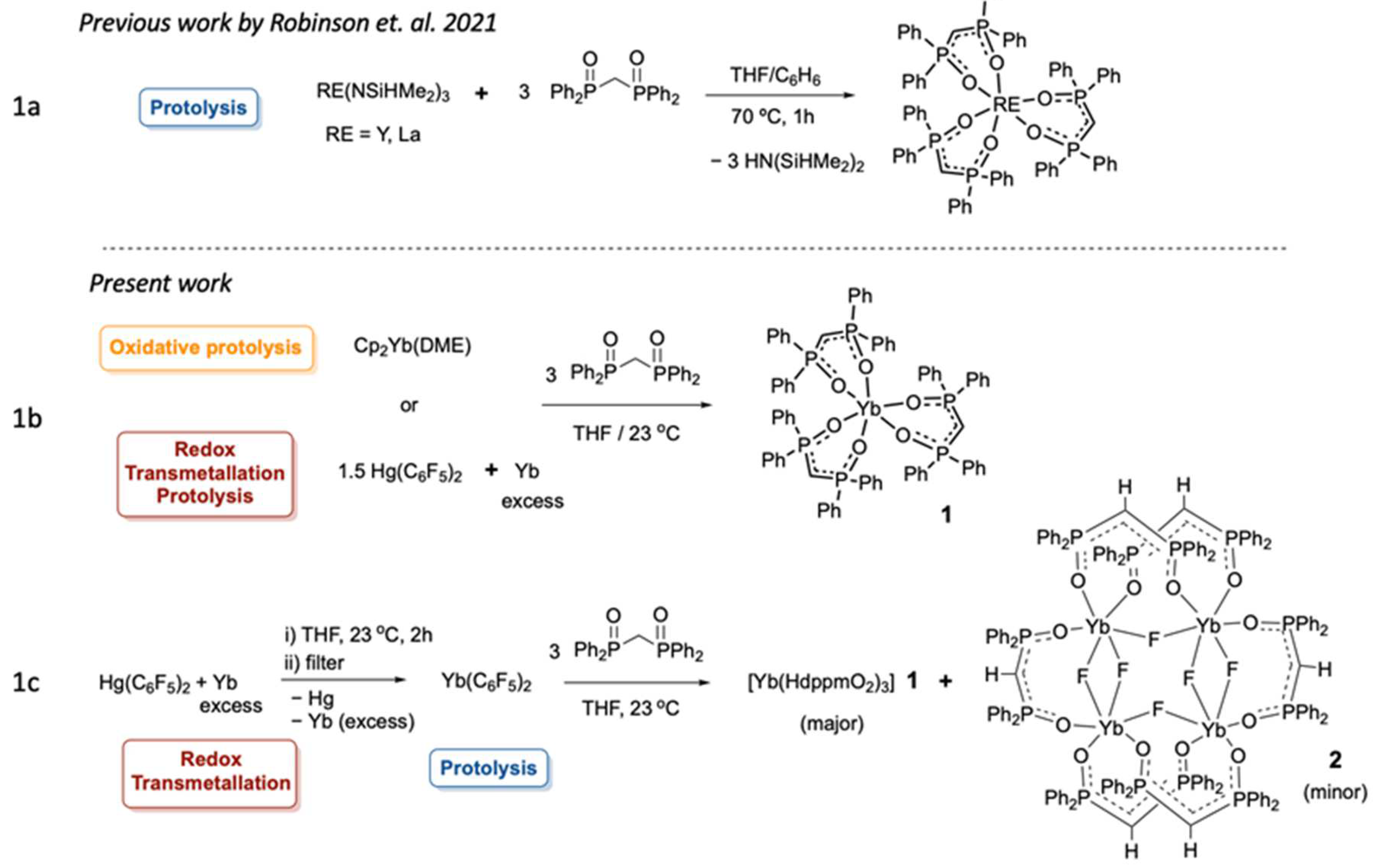
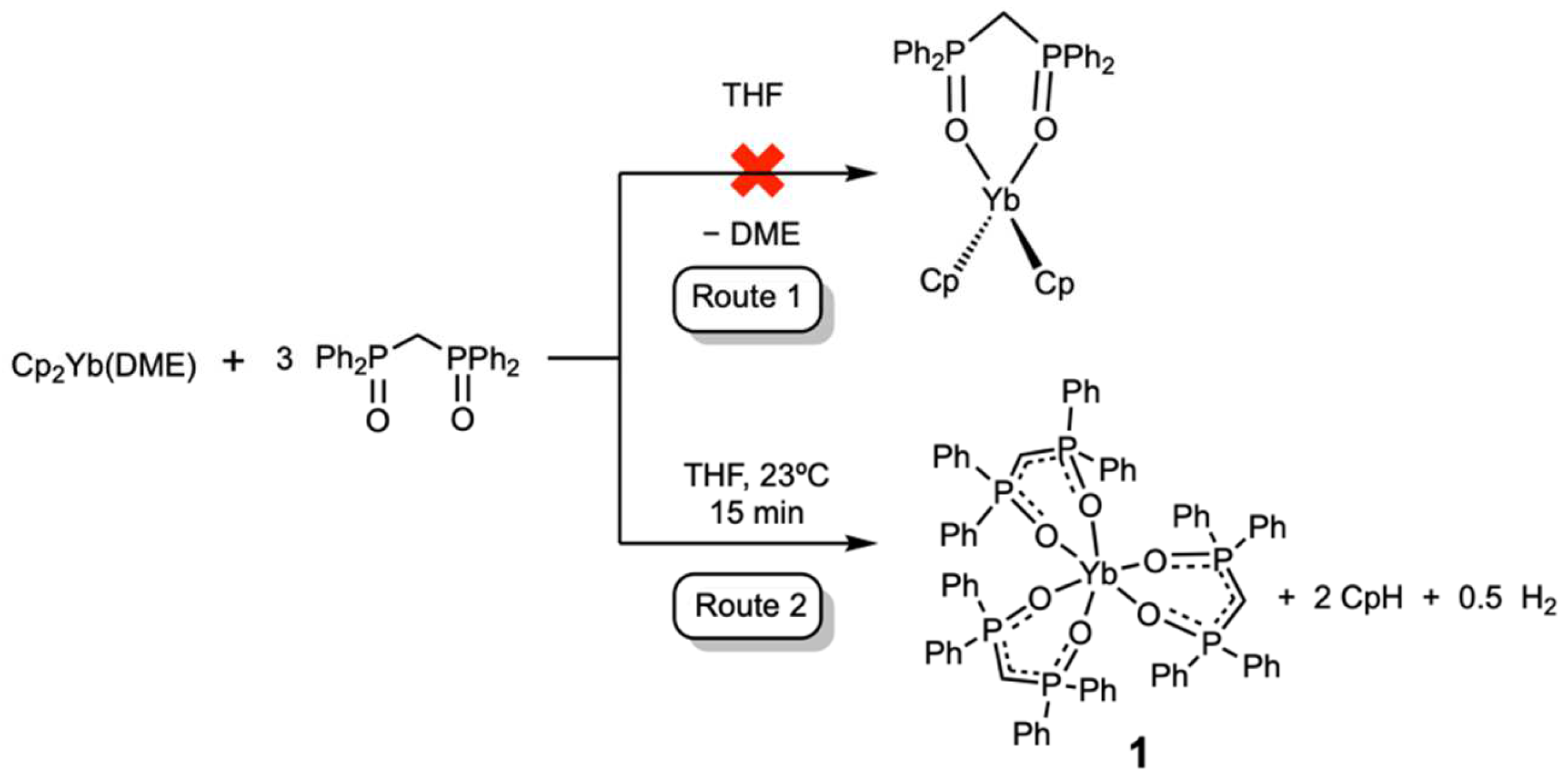
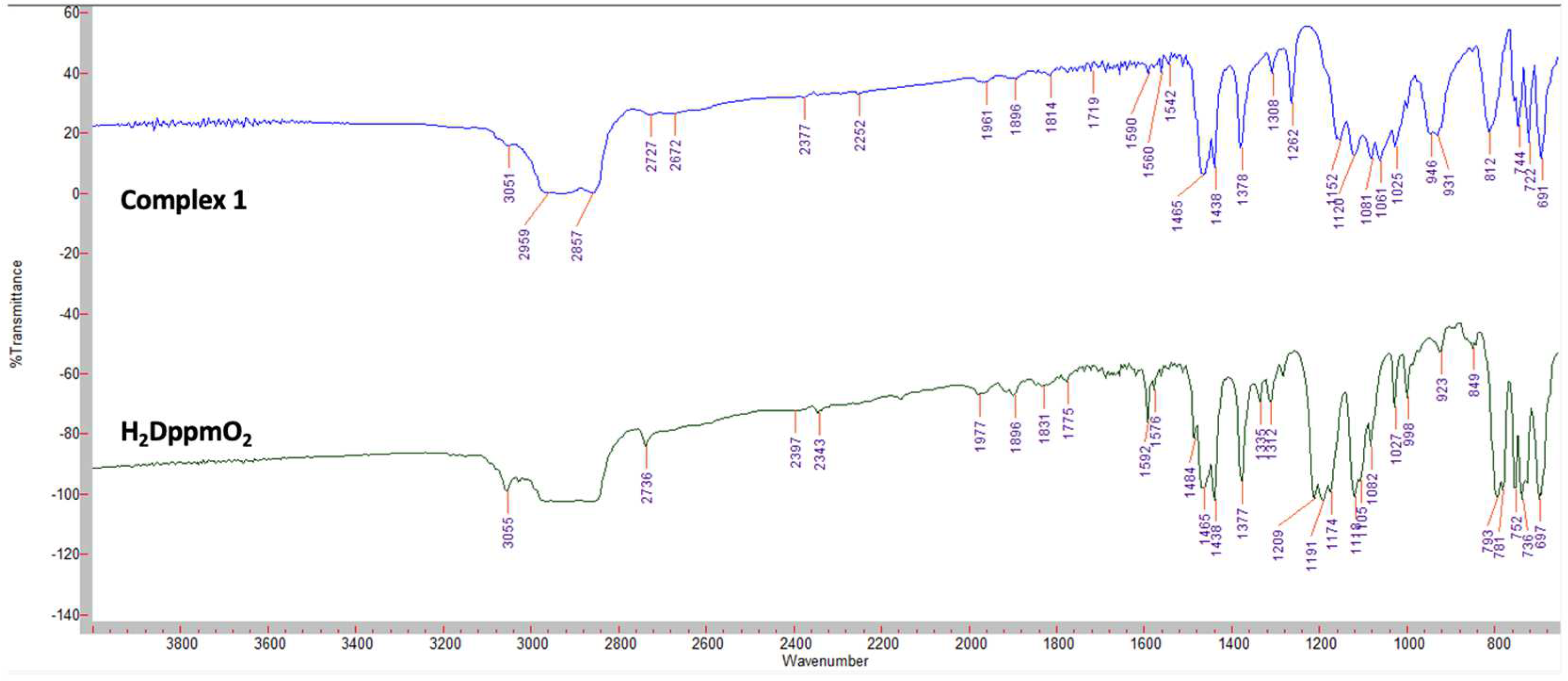

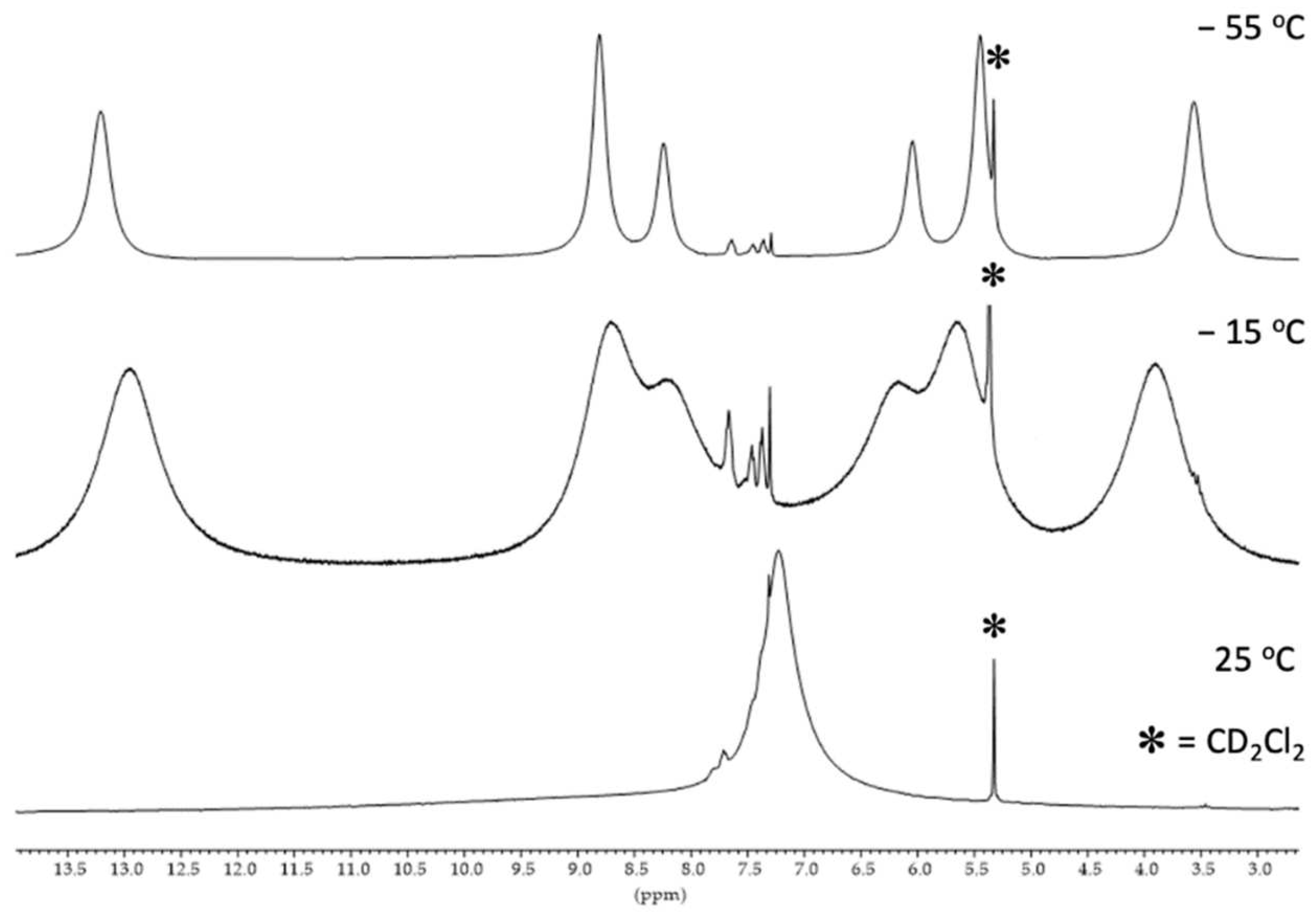
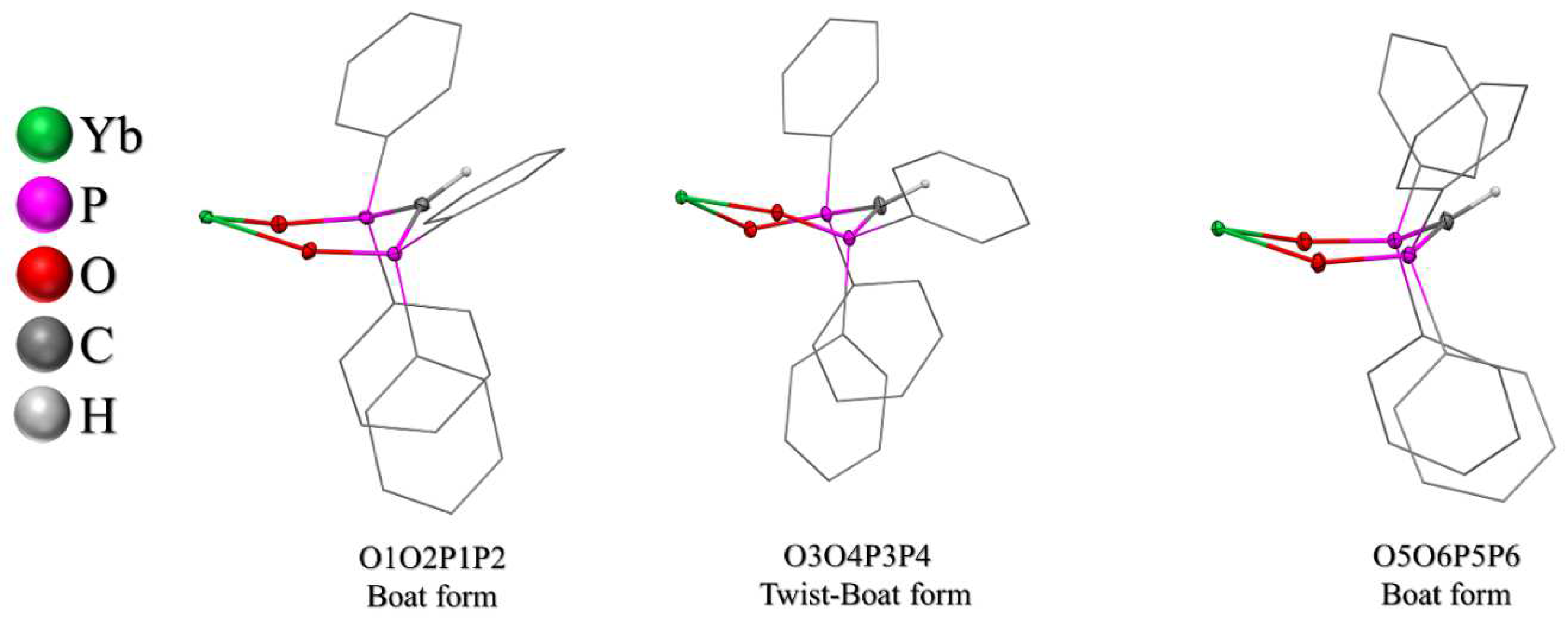


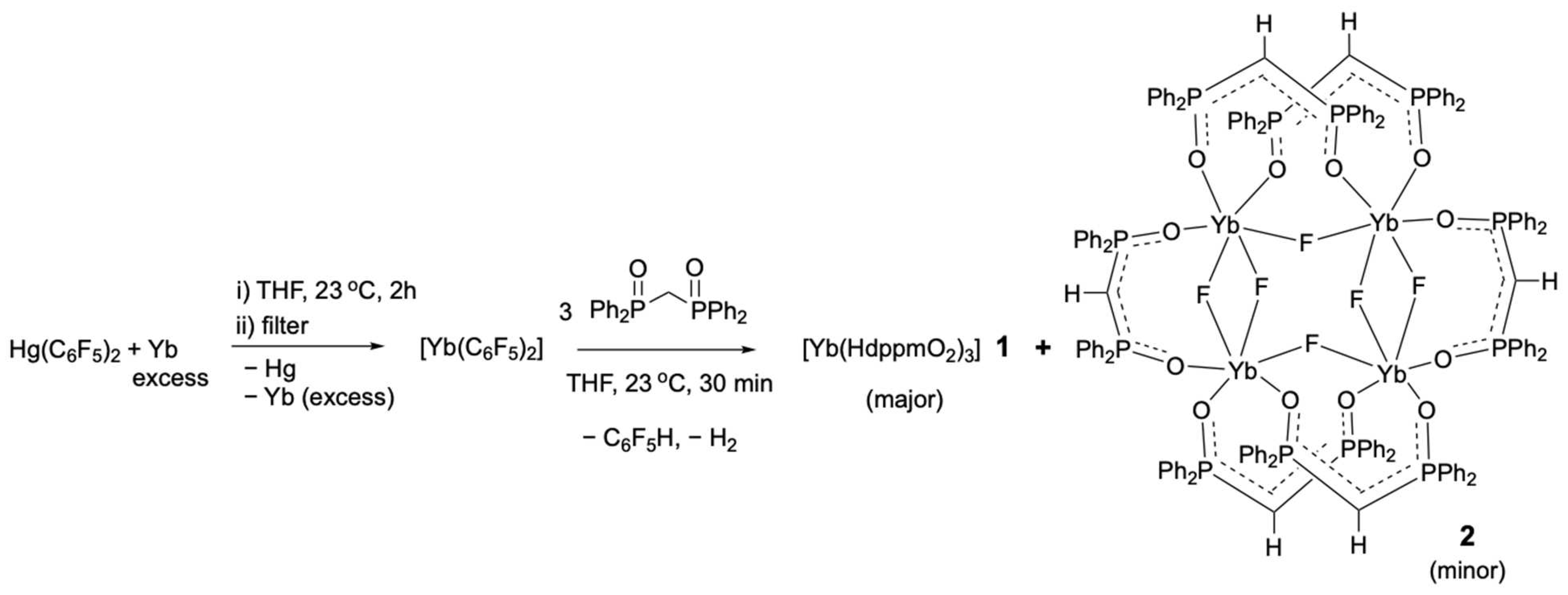
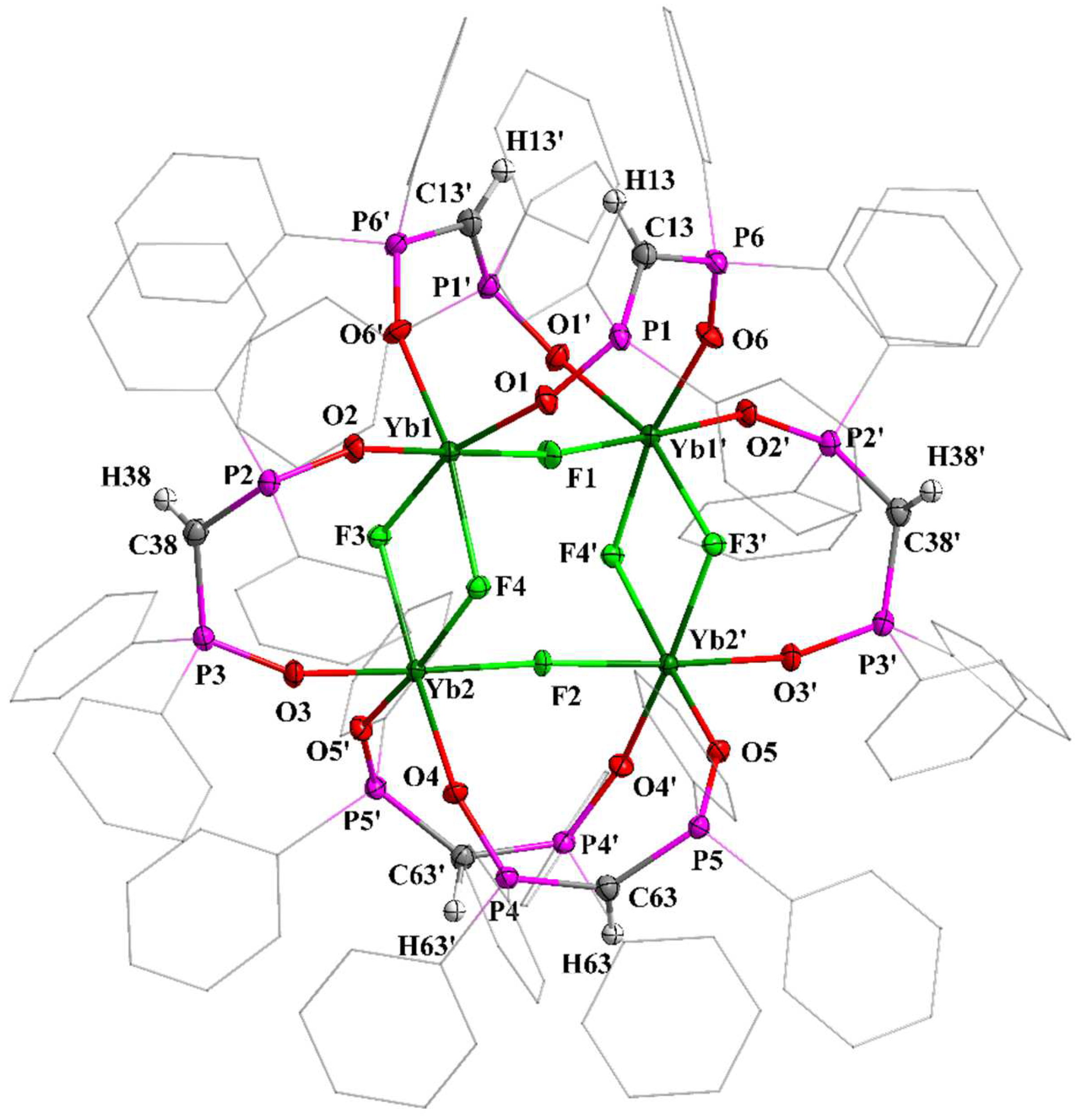
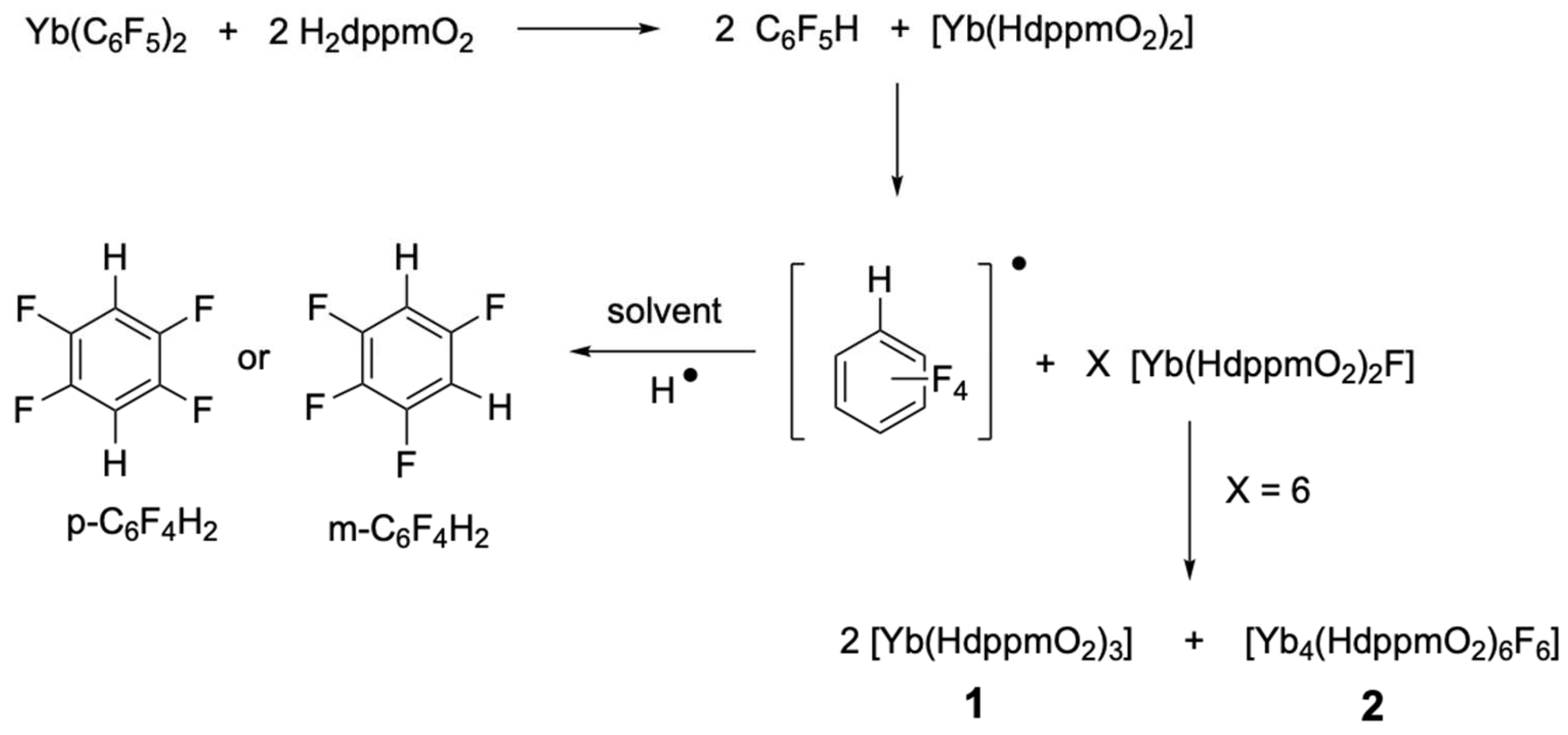
| O-P-P-O Mean Plane | Torsion Angle (°) | Conformer |
|---|---|---|
| O1-P1-P2-O2 | 8.03 (11) | boat form |
| O3-P3-P4-O4 | 30.05 (8) | twist-boat |
| O5-P5-P6-O6 | 4.18 (11) | boat form |
Publisher’s Note: MDPI stays neutral with regard to jurisdictional claims in published maps and institutional affiliations. |
© 2022 by the authors. Licensee MDPI, Basel, Switzerland. This article is an open access article distributed under the terms and conditions of the Creative Commons Attribution (CC BY) license (https://creativecommons.org/licenses/by/4.0/).
Share and Cite
Rangarajan, S.; Beaumont, O.A.; Balakrishna, M.S.; Deacon, G.B.; Blair, V.L. Synthesis and Characterisation of Novel Bis(diphenylphosphane oxide)methanidoytterbium(III) Complexes. Molecules 2022, 27, 7704. https://doi.org/10.3390/molecules27227704
Rangarajan S, Beaumont OA, Balakrishna MS, Deacon GB, Blair VL. Synthesis and Characterisation of Novel Bis(diphenylphosphane oxide)methanidoytterbium(III) Complexes. Molecules. 2022; 27(22):7704. https://doi.org/10.3390/molecules27227704
Chicago/Turabian StyleRangarajan, Shalini, Owen A. Beaumont, Maravanji S. Balakrishna, Glen B. Deacon, and Victoria L. Blair. 2022. "Synthesis and Characterisation of Novel Bis(diphenylphosphane oxide)methanidoytterbium(III) Complexes" Molecules 27, no. 22: 7704. https://doi.org/10.3390/molecules27227704
APA StyleRangarajan, S., Beaumont, O. A., Balakrishna, M. S., Deacon, G. B., & Blair, V. L. (2022). Synthesis and Characterisation of Novel Bis(diphenylphosphane oxide)methanidoytterbium(III) Complexes. Molecules, 27(22), 7704. https://doi.org/10.3390/molecules27227704






